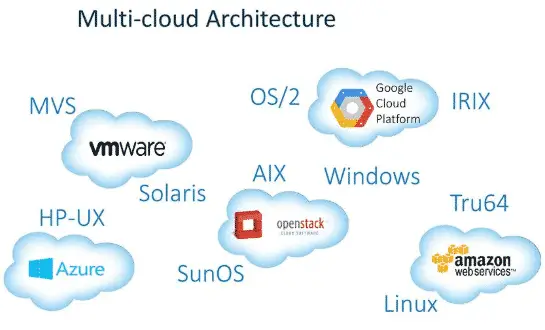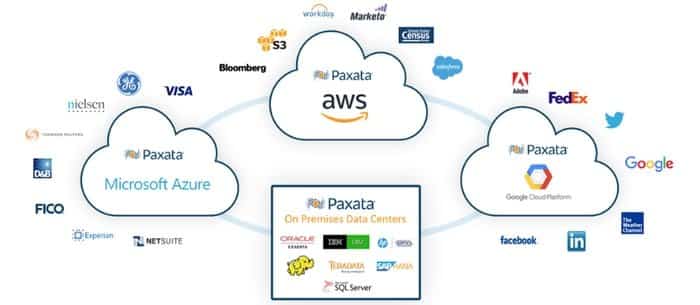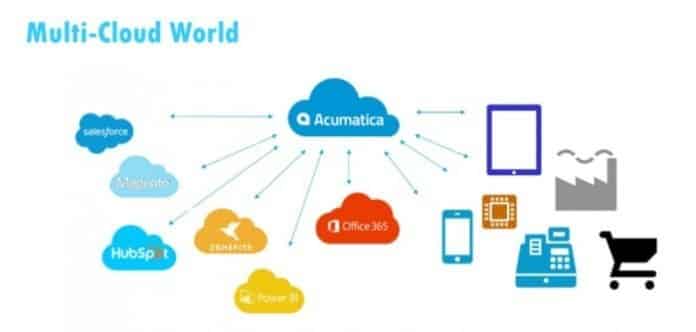Multi-cloud strategy means the use of multiple cloud computing storage for an individual heterogeneous organization. Basically, a multi-cloud strategy is the distribution of software applications and cloud assets. Multi-cloud is the utilization of public cloud, private cloud, and hybrid cloud on the same platform. This cloud aims to eliminate the dependency on a single cloud service provider.
We can clarify multi-cloud through a beautiful example. The big organization can concurrently use multiple cloud software like IaaS, SaaS, and PaaS. Different cloud service providers for those solutions. The infrastructure is also different. But the combination of different clouds can make multi-cloud.
Multi-Cloud Strategy
The multi-cloud strategy means the use of multiple cloud computing services. This strategy includes the implementation of Software as a service (SaaS), infrastructure as a service (IaaS), and platform as a service (PaaS). There are numerous cloud service providers like Google Cloud, AWS, Microsoft Azure, one drive, cloud foundry, OpenStack, etc.

Common Uses for Multi-Cloud Computing
The term multi-cloud comes from tension. Many organization pursues this strategy for the tension of uncertainty. This strategy was adopted to prevent data loss. The main secret of this cloud is to avoid vendor lock-in. Because of this cloud strategy, now the user has the bargaining capacity with the vendor.
Some organization uses this strategy for data sovereignty. There are certain rules and regulations with the corporate policy to keep data physically to other locations. Multi-Cloud helps the organization to full fill the requirement. This enables the organization more flexibility.
Adopting Multi-Cloud Infrastructure
 These kinds of infrastructure the combination of different types of cloud computing. A multi-cloud structure gives you a reliable cloud solution. This combination of the private cloud network, public cloud hosting, hybrid combination cloud computing, saas, pass, and IaaS. To adopt the multi-cloud strategy, we should adopt certain issues, which are:
These kinds of infrastructure the combination of different types of cloud computing. A multi-cloud structure gives you a reliable cloud solution. This combination of the private cloud network, public cloud hosting, hybrid combination cloud computing, saas, pass, and IaaS. To adopt the multi-cloud strategy, we should adopt certain issues, which are:
- Ensure multiple geographies
- Optimize the costs
- Maintain cloud service provider leverage
- Future-proof cloud strategy
- Create resilient architectures
- Leverage present investments
What Does Multi-Cloud Offer?
The cloud offers a different service as like:
1. Cloud Transfer
This cloud transfers files, cloud drives, FTP, and WebDev.
2. Cloud Syne
It offers mirror sync, move sync, one-way sync, two-way sync, simple sync, cumulative sync, update sync, incremental backup sync, and full backup sync.
3. Cloud Explorer
Multi-Cloud manages various cloud storage like Windows Explorer, including downloading, uploading, renaming, deleting, and previewing cloud files. It can create a new cloud folder, move, cut/copy & paste and share files across clouds. This system connects multiple cloud services to make a single robust cloud service.
The Pros of Multi-Cloud Multi-Strategy
The workload of multi-cloud moves among different cloud service providers. Based on the dynamic character, the multi-cloud has different Pros and Cons like:
1. Reduce vendor dependency
Multi-cloud shows opportunities to use many vendors. It deploys a different application. This facilitates switching over to the cloud service.
2. Hybrid Platform
This cloud service is a combination of private cloud and public cloud and makes it a hybrid cloud. In this cloud, people consider performance, cost, and security. Moreover, hybrid multi-cloud provides faster service.
3. Comprehensive proficiencies
Service from different platforms provides different capabilities. The options really depend on the demand of the user, budget. If everything is all correct, then it is comprehensive.
4. Negotiation power
There is a proverb,” Customer is the king”. The multi-cloud strategy empowers the user from the vendor lock-in curse. Now they have the Negotiation power to match their demand and service.
The Cons of Multi-Cloud
1. Different API
The different cloud service provider provides different cloud API service. This API helps to coordinate different services. It requires an application setup and API management.
2. Complex strategy
The biggest challenge to implement a multi-cloud is its complex structure. Different interfaces, different technology, and different service make it more complex.
3. Need Management Overhead
Since cloud implementation is not an easy task, so it needs management overhead. The hybrid formation is required to plan and coordinate the cloud. Expertise in diverse domains requires working the system effectively and efficiently.
4. Increase Ops burden
Many men, many minds. Many processes are a burden to the organization. So the process multi-cloud can be a burden to the organization because of its complex nature.
The Mistakes in Multi-Cloud Computing
Working with multiple vendors is a complex issue. It requires more time and money, and effort. You are playing with big data in the cloud world, and it is not a short-time play. As a result, you have to be more conscious regarding deciding on multi-cloud computing. Some mistakes to overcome are:
1. Going to multi-cloud without enough cloud competency
As an organization, it is the sequence of steps to implement cloud or multi-cloud strategy. If the organization does not have enough competency, it is not wise to jump for a multi-cloud strategy. First of all, they need to go for a simple cloud then a multi-cloud. Without the feasibility study, it will not be wise to invest in IaaS, PaaS, and SaaS multi-cloud.
2. Complexity into strategy
The word “Multi” means more. Multi-cloud includes more flexibility, more storage, more reliability, more liberty, and more functions. But there is a big question about more. More problems may arise, more money needed, more maintenance required, etc. The complex issues are:
- Load balancing
- Staff skill levels
- Latency
- Health monitoring
- Code deployment
- Latency
- Security
3. Assuming cost saving
Expenditure of the cloud is another great example. It is unwise to assume that a multi-cloud will reduce your cost. It is only to reduce your tension. Since the multi-cloud is the combination of different cloud service providers, then the cost will be high.
4. Overestimating the benefits of security
Security of data is a big issue. In a multi-cloud strategy, there is the question of data security. If the valuable data of your organization transfer to your competitors, then what will happen? Obviously, it needs to overestimate the security cost.
5. Fail to control the scope and growth
Taking the prefix the word “Multi” is wrong. Without feasibility study, implementation of multi-cloud strategy may hamper the control of scope and growth.
Is Multi-Cloud Strategy feasible for Paas SaaS and IaaS?
The question has many answers. Actually, it depends on the requirement. This is the game of big data, and multi-cloud is the field of the game. The multi-cloud strategy is the coach of the team. Now the question is should we follow or adopt the multi-cloud strategy or not? Is a multi-cloud strategy suitable for PaaS, IaaS, and SaaS? My next discussion will direct you to the answer.
What is the difference between SaaS PaaS and IaaS?
The SaaS Vs. PaaS As IaaS is a common feature of cloud computing. The first one is service, the second one is a platform, and the last is infrastructure. For better assimilation, we will discuss in detail the definition of Saas, Paas, and Iaas.
PaaS
Platform as a service or PaaS is the one segment of cloud computing. PaaS offers the platform to cloud developers. Only one platform is enough, so it does not require a multi-cloud service. It does not require and hosting, or storage service execrate to simple cloud computing. As a result, using the only platform as a service does not require a multi-cloud strategy.
IaaS
Infrastructure as a service or IaaS refers to the computer architecture of high capacity. If the company does not have the purchasing capacity of powerful architecture or thinks for rental basis, they choose the IaaS service. In the single cloud computing system, IaaS is more than enough. So implementing the multi-cloud strategy in IaaS is a wastage of money.
SaaS
Software as a service or SaaS is the solution provided by a cloud service provider. They also offer cloud storage, so here multi-cloud strategy may require. The multi-cloud strategy is required for protecting the organization from vendor lock-in service because the vendor is providing the cloud server.
Final Thought of Multi-Cloud Strategy
Cloud computing is an interesting issue. People have habituated the terminology of cloud computing. Though the technology is new, the response is high. However, the decision of a multi-cloud strategy is a complex one. The proper feasibility study should require to implement the multi-cloud strategy.





